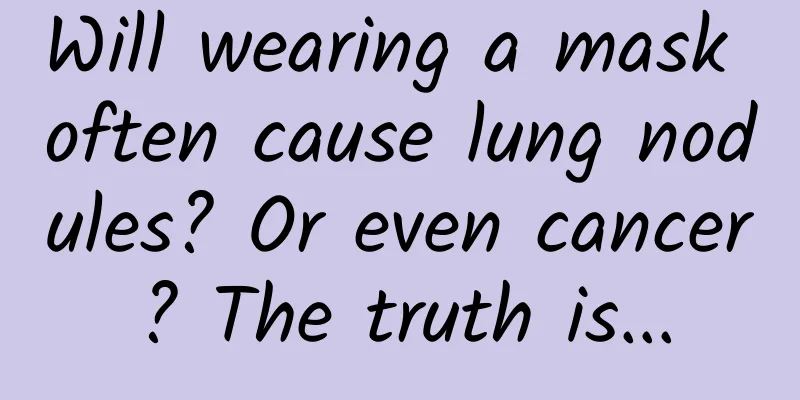Will wearing a mask often cause lung nodules? Or even cancer? The truth is...

|
In the past two days, a short video has been widely shared in many groups. In the video, a so-called "internal medicine doctor" said: "Frequently wearing a mask will cause lung nodules, and the ethylene oxide in the mask is carcinogenic and affects your health." Do these statements make sense? Let me first state the conclusion: this is a typical medical rumor . Using so-called professional identities, adding a few technical terms, and then leveraging on health issues that everyone deals with every day and is very concerned about, it is finally widely spread. But the result of the spread is not to bring health to everyone, but to increase people's anxiety. It will also increase the possibility of infection with the new coronavirus and other pathogens because of people's resistance to wearing masks. Next, let’s talk in detail about why this rumor is wrong. Key Points In most cases, “lung nodules ≠ lung cancer”, so there is no need to worry too much. The increase in lung nodule detections is mainly due to more advanced detection methods and more frequent screening, and has nothing to do with masks. Qualified medical surgical masks will not drop debris and be inhaled into our lungs to cause harm during normal use. Sterilized with ethylene oxide The content of ethylene oxide in the masks after use is negligible and will not affect health. Good hygiene habits, including wearing masks correctly, remain one of the effective ways to protect against the new coronavirus. 01 Why are there “more lung nodules”? Are the lung nodules found in many people's physical examinations recently related to wearing masks and doing nucleic acid tests? The so-called pulmonary nodules refer to round or nearly round shadows with a diameter of less than or equal to 30 mm found in lung plain films or CT scans . Shadow? Many friends are frightened when they hear this. Isn’t shadow generally synonymous with cancer? In fact, we are worrying too much. If you don't believe me, just look at the statistics of recent years, or talk to your colleagues after the physical examination organized by the company, you will find out how common lung nodules are. In a way, just as a person may develop wrinkles or gray hair, most people will develop some lung nodules as they age . Why haven’t people heard of so many lung nodules before? One of the more important reasons is that previous X-ray examinations did not have enough resolution, and CT was too expensive and few people did it, so so many nodules could not be detected. Now, medical imaging technology has improved, making it easier to detect lung nodules, and it has nothing to do with masks . It's like if you use a magnifying glass to check, you can find more pits on everyone's face, but can we say that everyone's skin has become worse? Copyright image, no permission to reprint So, among so many people who have been diagnosed with lung nodules, how many of them actually have lung cancer? Even if a clinical doctor determines that a lung nodule is suspected to be malignant, more than 90% of it will be benign after examination and exclusion. Even if those are judged to be malignant and are eventually removed surgically for safety reasons, subsequent biopsies will prove that at least 30% are benign. Therefore, it can be said that in the vast majority of cases, "lung nodules ≠ lung cancer." The causes of benign lung nodules are varied, including air pollution, bacterial infection, vascular disease, inflammatory disease, etc., but these have nothing to do with masks. In short, we usually don’t need to feel anxious about lung nodules found during physical examinations. If there are indeed suspicious lung nodules, doctors will often recommend several regular examinations so that a more accurate judgment can be made. Some friends may be worried because some people say that "residues" will fall off the mask and may cause various harms if inhaled into the lungs. Copyright image, no permission to reprint This worry is quite reasonable. However, because our respiratory tract has the function of self-cleaning, it can block many foreign objects from entering the alveoli. The only particles that can actually enter the alveoli are the PM2.5-PM10 size that we are very familiar with. According to a report from the Shanghai rumor-busting platform, relevant sources pointed out that meltblown cloth is the core material of masks. It uses petrochemical product polypropylene as the main raw material and has a polymer structure . Under normal circumstances, the molecules are bonded together and it is impossible to "degrade" or "release" small particles. From the perspective of application scenarios, plastic products and related raw materials are widely used around the world, including medical use, food, etc., and the application is becoming more and more extensive. If these products are harmful to the human body, how can they be used in these applications? At the same time, qualified plastic products and related raw materials that are put on the market must undergo professional testing to meet national and industry standards , and there is no risk of online transmission. To sum up, most lung nodules detected by physical examinations are benign. The increase in lung nodule detections is mainly due to more advanced detection methods and more frequent screening, but this is not caused by masks. Qualified medical surgical masks, under normal use, will not fall off and be inhaled into our lungs to cause harm. And wearing a mask correctly can protect us from inhaling pathogens or other foreign matter . Since there is nothing wrong with the mask itself, what about the ethylene oxide used to disinfect the mask? 02 Is ethylene oxide carcinogenic? Some friends may be worried that ethylene oxide is used to disinfect masks, thinking that this substance can cause cancer and will definitely affect health. Is this really the case? Ethylene oxide, with the chemical formula C₂H₄O and the abbreviation "EO", is a common and easy-to-use disinfectant. Ethylene oxide is one of the most important low-temperature sterilization methods at present . Food packaging, baby diapers, sanitary napkins, etc. can all be sterilized with ethylene oxide, of course, including medical devices such as masks. Schematic diagram of the structure of ethylene oxide. Copyright image, no permission to reprint To be honest, like many disinfectants, ethylene oxide is indeed toxic. If you inhale too much ethylene oxide gas at one time, you will be poisoned on the spot. Frequent exposure to ethylene oxide is also harmful to your health and increases the risk of cancer. However, only workers in related industries need to guard against these dangerous factors, and ordinary people do not need to worry about them . Moreover, precisely because ethylene oxide has a certain degree of toxicity, the country has strict standards for the use of ethylene oxide to disinfect masks. According to the industry standard "Medical Surgical Mask" (YY0469-2011), the residual ethylene oxide in masks sterilized with ethylene oxide should not exceed 10μg/g . In other words, we unpack a mask, cut off 1 gram of mask fabric, extract and measure it, and the ethylene oxide in it should not exceed 10μg. In order to meet this standard, masks disinfected with ethylene oxide need to be air-dried in a ventilated desorption room for 1-2 weeks to allow the ethylene oxide to dissipate. After that, they need to undergo a sterility test after 2 weeks and can only be shipped out after meeting the standard. Copyright image, no permission to reprint Therefore, the ethylene oxide content in the masks we usually use is already negligible, and when we wear masks, part of the remaining ethylene oxide will escape into the air, and we actually inhale even less. If you compare the residual limit of ethylene oxide, you will find that, based on the weight of a medical mask of about 3g, each mask contains a maximum of 30μg of ethylene oxide. If the daily dose is ≤ 0.1mg (1mg=1000μg) for prolonged contact, you have to swallow at least 3 masks a day to exceed the limit. The premise is that you have to cover yourself tightly when swallowing , otherwise the ethylene oxide will escape into the air... (Please do not imitate this thought experiment) Data from GB/T 16886.7-2015, ISO 10993-7 What's more, some masks are disinfected using other methods and do not use ethylene oxide. Therefore, qualified masks purchased through formal channels can be worn with confidence without having to worry about ethylene oxide . To sum up, good hygiene habits, including wearing masks correctly, are still one of the effective ways to resist the new coronavirus. But don’t give up safe and effective protection methods because of some popular rumors and put your health at risk. Author: Rutan Review | Tang Qin, Chief Researcher, Science Popularization Department, Chinese Medical Association The cover image and some images in this article are from the copyright library Reproduction of image content is not authorized |
Recommend
The system's housekeeper - SystemServer process
[[374543]] This article is reprinted from the WeC...
Reward Collection | The second issue of Aiti Tribe Stories is officially launched
Dear developers, The wonderful stories of each de...
The Lanzhou server next to the company crashed again
Noon The haze in the imperial capital has not yet...
How to do knowledge marketing by Baidu promotion? Cases and optimization ideas
Now is the end of the year, and Baidu's resou...
bmob personal lost property application_app development template
Source code introduction The source code is very ...
Global iPhone supply is limited in the short term: Apple's US website also begins to limit purchases
Beijing time, March 20th morning news, according ...
Monetize billions of traffic in second, third, fourth and fifth tier cities! The first trick to sink!
From 2017 to 2019, China's Internet entered a...
Transaction Gold Link Apollo Mobile Terminal Abnormal Monitoring System
Overview 01Business Background and Purpose Genera...
Chery executives asserted that domestic smart driving lags behind Tesla, and Musk probably covered his face in shame
A bolt from the blue, Tesla FSD is coming to Chin...
What should we pay attention to in new media operations in vertical fields?
Who you tell it to decides what to say. Whether a...
The chip with "organs" is here! It is also the "universal drug tester" of the future
Recently, the artificial blood vessel chip develo...
Introduction to Baidu’s information flow advertising promotion billing methods and creative forms!
What is information flow advertising? Information...
Three methods of event planning and promotion: gameplay, dissemination and fission!
Today, based on the basic planning capabilities, ...
Xiaohongshu product operation analysis report
This article is a product analysis report of Xiao...
Five motivations for users to follow TikTok
How can you attract Douyin users and become an in...









